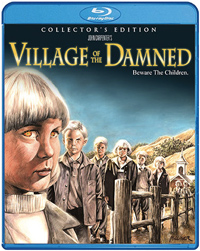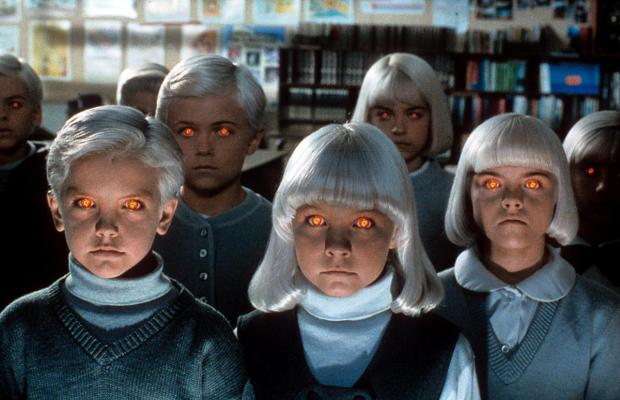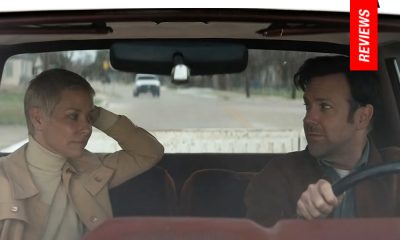Disc Reviews
Village of the Damned [Collector’s Edition] | Blu-ray Review
 Without a doubt, director John Carpenter has left an ineradicable imprint in our cinematic subconscious, playing a hand in the creation of several major film movements, such as the slasher subgenre with serial killer Michael Myers in Halloween (1978), while his 1974 debut Dark Star was a space comedy hybrid which would eventually pave the way for Ridley Scott’s Alien (1979). Arguably, Carpenter was most prolific in the 1980s, reinventing Kurt Russell’s star persona through several iconic vehicles and fostering an offbeat filmography of original sci-fi and horror genre pieces. The 90s were less kind to Carpenter’s particularly tactile sensibilities, and like many genre auteurs, the early succession of CGI technology perhaps assisted in the downfall of his considerable acclaim. Several of his once denigrated items have since been recuperated by a vibrant cult following, such as 1998’s Vampires, while 1994’s indelible In the Mouth of Madness still stands as one of his most unnerving creations. But his 1995 remake of the classic 1960 British sci-fi horror film Village of the Damned was essentially dismissed by critics upon release, raking in only half of its twenty million plus budget, and scoring a Golden Raspberry nomination for Worst Remake.
Without a doubt, director John Carpenter has left an ineradicable imprint in our cinematic subconscious, playing a hand in the creation of several major film movements, such as the slasher subgenre with serial killer Michael Myers in Halloween (1978), while his 1974 debut Dark Star was a space comedy hybrid which would eventually pave the way for Ridley Scott’s Alien (1979). Arguably, Carpenter was most prolific in the 1980s, reinventing Kurt Russell’s star persona through several iconic vehicles and fostering an offbeat filmography of original sci-fi and horror genre pieces. The 90s were less kind to Carpenter’s particularly tactile sensibilities, and like many genre auteurs, the early succession of CGI technology perhaps assisted in the downfall of his considerable acclaim. Several of his once denigrated items have since been recuperated by a vibrant cult following, such as 1998’s Vampires, while 1994’s indelible In the Mouth of Madness still stands as one of his most unnerving creations. But his 1995 remake of the classic 1960 British sci-fi horror film Village of the Damned was essentially dismissed by critics upon release, raking in only half of its twenty million plus budget, and scoring a Golden Raspberry nomination for Worst Remake.
In the sleepy town of Midwich, a strange sleeping sickness suddenly overtakes everyone in residence, causing several tragic mishaps. Inviting international attention for the unexplainable event, the shaken community attempts business as usual, until they discover an unprecedented amount of pregnancies dating to the day of the blackout. The local physician Dr. Alan Chaffee (Christopher Reeve) and his wife Barbara (Karen Kahn) are among the afflicted, and a sarcastic government scientist, Dr. Susan Verner (Kirstie Alley) arrives to monitor the situation. It seems the Midwich women are not the only population experiencing this phenomenon, either. But when the children are born, none of them look like their parents, instead all platinum blond with notable intelligence and possible telepathic communication skills amongst themselves. As the children grow, people begin to notice strange things about their eyes, which take on an iridescent glow whenever someone wrongs them…and soon it becomes apparent all the horrible accidents in Midwich can be attributed to the strange offspring.
The neglect and overwhelming disdain for Carpenter’s update seems somewhat unwarranted, especially considering the hoariness of the original, a B-grade genre effort from German director Wolf Rilla starring George Sanders and Hammer star Barbara Shelley. Carpenter stays close to the source material, but his marked adjustments add considerable subversive subtext to the scenario. John Wyndham’s (a sci-fi author usually transfixed with post-apocalyptic scenarios, such as The Day of the Triffids) original 1957 novel was titled The Midwich Cuckoos, an allusion to the cuckoo bird, a creature which lays its eggs in others bird’s nests to fool them into raising their young. The concept of woman as the host vessel for pregnancy is chilling, and the original novel plays with vague concepts of body horror as metaphor for political infringements (not unlike the more famous Invasion of the Body Snatchers). But Carpenter relocates the setting to contemporary Northern California in a coastal set rural community, and his coding of gender and race are of particular note.
The mysterious, telepathic children have always had a disturbing Aryan look about them, all with white (or possibly platinum blond) hair, and rigidly militaristic in their socialization and behavior. Their unknown origin could just as easily be explained as a Nazi experiment, not unlike Ira Levin’s The Boys from Brazil cloning, or some other such Josef Mengele inspired atrocity. Maintaining the basic thrust of an alien presence choosing isolated communities to cultivate their power and dominance, Carpenter’s updated scenario suggests interesting theories on the importance of individuality vs. community. While the original takes places in a logically hegemonic community, the relocation to a rural, privileged population of affluent white people provides some interesting observations. Something has chosen to infiltrate what’s considered the predominant culture, miming assimilation into Anglo-Saxan tenets dependent upon specific, and conservative social cues regarding political correctness (which is also breeding ground for dangerous naiveté).
Carpenter slyly injects commentary through the casting of one significant non-white character, Karen Kahn as Christopher Reeve’s Asian-American wife, whose child clearly has none of her genetic make-up (besides the brief appearance of a black police officer, and a broodingly styled Kirstie Alley, everything about this Midwich is, besides white, quite ‘blonde,’ with Linda Kozlowski and Constance Forslund almost interchangeable in their whiteness).
Ironically, it’s the traditional values of the Midwich (i.e. white) community allowing an alien presence to not only exist but assume totalitarian control. Notions of empathy, individuality, and the age old hypothetical formulation of nature vs. nurture buzz around emphatically in the transparent metaphors of Village of the Damned. Much like the innate terror of isolation in the Antarctica set The Thing, Carpenter takes this a step further with this study of controlled populations detached from the metropolis and how they are prone to a different kind of vulnerability. Subconscious urban paranoia (at least in this mid-90s set tale) leads to a dangerous lack of diversity, and, therefore, a lack of potential checks and balances regarding appropriate behaviors and norms.
But despite the film’s metaphorical implications (which also questions, quite neatly, how children are used as state funded, economic resources for their parents) it also manages to be quite entertaining, even with David Himmelstein’s sometimes hokey screenplay and a cat-like Kirstie Alley doing her best as a government vamp. Notably, this was Christopher Reeve’s last feature before his devastating horse-riding accident, while Crocodile Dundee star Linda Kozlowski would only appear in two more films. Mark Hamill is a notable supporting player as the village reverend, while child star Thomas Dekker appears in one of his first roles.
Disc Review:
Carpenter’s maligned title gets a refreshing treatment with Scream Factory’s new, invigorating release, presented in widescreen 2.35:1 with DTS-HD Master Audio 5.1 (greatly enhancing Carpenter and Dave Davies’ pronounced and wonderfully eerie score). Regular Carpenter DP Gary B. Kibbe whips up a soap opera lensed postcard portrait of the perfect idyllic community, swiftly demolished by an insidious presence, while the film’s visual design and special effects have held up quite well. A bevy of special features are also worth checking out on this pleasurable re-release.
It Takes a Village:
This near hour long featurette on the making of the film includes interview footage with John Carpenter (who refers to the film as an assignment), producer Sandy King, make-up artist Greg Nicotero, and a number of the supporting cast members (including several of the children, now grown),
Horror’s Hallowed Ground:
An episode of the Sean Clark series revisits several of the film’s shooting locations in this twenty minute segment.
The Go to Guy:
Actor Peter Jason reflects on his experiences working with Carpenter in this forty-five minute feature.
Vintage Interviews:
This twenty-four minute feature includes vintage interviews from cast and crew as well as behind the scenes footage from the making of the film. Carpenter professes great admiration for his three leads (Reeve, Kozlowski, Alley).
Final Thoughts:
Fans of John Carpenter and vintage sci-fi should revel in this overdue transfer of a compelling film. Although it’s not in the same league as Carpenter’s other notable remake (his 1982 version of The Thing remains unparalleled), it’s well worth reassessment.
Film Review: ★★★/☆☆☆☆☆
Disc Review: ★★★½/☆☆☆☆☆































